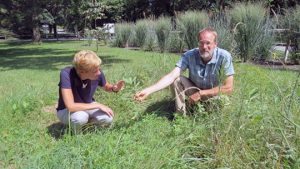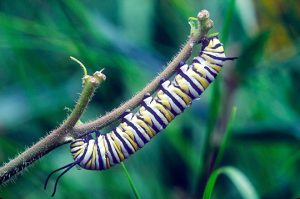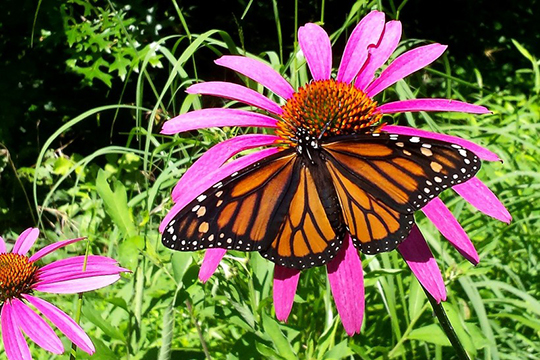The monarch butterfly may soon be on the U.S. Fish and Wildlife’s Endangered Species List. Since the 1990s, the number of monarchs across North America has declined by more than 80 percent, from almost one billion to about 56.5 million today.
Over-logging in Mexico — where the butterflies live in winter — is wiping out the monarch’s southern forest habitat and, in the United States, development, land management practices, and chemicals used in agriculture are making it hard for the monarch to survive. Climate changes, including an increase in severe storms and colder weather, are challenging the monarchs.
The Brandywine Conservancy & Museum of Art is doing its part to reverse the trend. What started as an idea to stop mowing certain areas on the organization’s campus to let the native vegetation grow has evolved into dedicating an area to support the life of the monarch butterfly.
Noting that the effort is consistent with the conservancy’s mission and its approach to landscaping, the “Monarch Migration Station” is having its intended result, according to Mark Gormel, horticultural coordinator, and Edie Dondero, associate director for land stewardship. The two are spearheading the conservancy’s effort to save the monarch.
According to Dondero, “The more habitats we create here in Pennsylvania will increase the chances that the monarch population will withstand the many threats it faces.”
Last year, under the guidance of Gormel, volunteers and staff planted butterfly-attracting species like milkweed, black-eyed Susan and coreopsis in the migration station. Now, the plants are mature and the garden is abuzz with butterflies of all sorts, including the easily recognizable monarch with its distinctive orange stain glass-like wings.
Gormel has seen more than one female butterfly on the milkweed.

“You see her belly push out, and then there’s an egg under the leaf,” he said. “[It’s] about the size of a dot from a pen point,” he marvels.
There is now a mowed path through the garden, and future plans include signage and benches so visitors may sit and observe the butterflies.
The annual fall migration of the monarchs is one of the world’s major natural phenomena. Monarchs from southern Canada and the U.S. arrive in central Mexico around November where they stay the winter in forested areas. These insects (which typically weigh one-fifth the weight of a penny) start the 1,500-mile return trip back in March, arriving around July.
A pending petition to the U.S. Fish and Wildlife Service to consider monarchs as a threatened species under the Endangered Species Act is helping to drive monarch conservation efforts. Researchers, non-governmental organizations, academic institutions, and agencies have collaborated under the Monarch Conservation Science Partnership to identify targets for monarch conservation.
For those interested in helping the butterflies, Dondero and Gormel recommend these steps:
Plant milkweed: This plant is the only plant on which female monarchs will lay their eggs. Try to plant it near background shrubs, or near foundation plantings to protect the butterflies from strong winds. Three milkweed plants that are native to our region--common milkweed, butterfly weed and swamp milkweed—are easy to grow in a range of soil conditions.

Grow sun-loving, nectar-producing plants: Adult butterflies feed on asters, black-eyed Susan, coreopsis, goldenrods, Joe-pye weed, purple coneflower, smooth oxeye, and wild bergamot. Make sure some of your plants are spring bloomers and fall bloomers. Plants like the ones mentioned here are available at the conservancy’s annual Wildflower, Native Plant and Seed Sale on Mother’s Day weekend and seeds of these plants are sold throughout the year in the museum’s gift shop.
Don’t use herbicides or pesticides: Chemicals like Monsanto’s Roundup will kill milkweed plants, and pesticides will kill monarchs as well as unwanted pests.
A word about the butterfly bush: Although this beautiful bush attracts scores of dancing butterflies, it is the equivalent of “junk food” for them. True, it provides nectar, but nothing else. If you have a butterfly bush, deadhead spent blooms throughout the summer so the plant won’t spread.
To learn more about the monarch butterfly and the U.S. efforts to protect the species visit:
www.brandywine.org/conservancy/landowner-resources/save-monarch-butterfly
https://www.fws.gov/savethemonarch/
http://www.monarchjointventure.org/get-involved/create-habitat-for-monarchs/
About Lora B. Englehart
Lora has a passion for art, gardening, yoga, music and dancing. She continues to research the life of locally born abolitionist and 1998 National Women's Hall of Fame inductee Mary Ann Shadd Cary. She is a dedicated community volunteer, working with the American Association of University Women, Wilmington, DE branch (programs chair), Chadds Ford Historical Society (former board member) and Brandywine Conservancy & Museum of Art. Lora lives in Birmingham Township with her husband Bill and son Brad. Daughter Erika lives in Pittsburgh with husband Bob and baby Wilhelmina. She is a former French, Spanish and ESL teacher, bilingual life insurance underwriter and public relations coordinator for Delaware Art Museum and Brandywine Conservancy & Museum of Art.



Comments